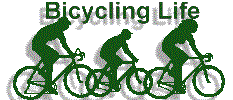Whoa! Whoa! Whoa! Hey, Frank, what do you think
you're doin'? I saw you run that red light!
Oh, hi Fred. Boy, that's irritating.
You think you're irritated 'cause I caught you? Just
wait till I tell everyone! Hoo, boy!
No, Fred. It's irritating that the light doesn't
work right! That's why I had to go through the red.
What do you mean it doesn't work right? Hey, it's
lit, ain't it?
Sorry, Fred. To be working right, a light has to
change from red to green in a reasonable amount of time. I sat there
for several minutes, just to see what would happen, then I treated
it like a stop sign. I'm not required to spend all day at a red
light!
Yeah, but look there! It just turned green for that
car. See? It works!
And that's especially irritating. The inductive loop
is set to detect cars. Its sensitivity isn't high enough to detect a
bike. Blast, I'm going to have to make another phone call to get it
adjusted.
Um... did you say deductive loop?
No, inductive. There's an oscillator circuit
connected to an inductive loop in the road, and it's resonant
frequency depends on the circuit's inductance. A car will change the
circuit's inductance enough to be detected, but they've got it set
too low to detect a bike.
Um... are you still speaking English? I don't even
see a loop!
Oh, sorry Fred. I was speaking Engineering. Here,
let's take a close look at the road. See that thin rectangular slot
they cut into the road, then re-filled? It's about five feet wide
and eight feet long.
Oh yeah. Did they bury something under that
rectangle?
No, they buried some wire in the rectangle.
They loop a few turns of wire around in that slot, then top up the
slot with a filler. The wire goes to the control box over there. It
uses an oscillating field in the wire loop to detect a car waiting
for the light. After a reasonable wait, it changes the light to
green. It doesn't waste time stopping the main road unless a car's
waiting.
Cool! Oh ... unless a car's waiting! Now I
get it. So it couldn't tell your bike was there, eh?
Right. I did everything I could, and it still
wouldn't trip.
Hah! Did you pretend you were a car? Did you gain
weight, or what?
No, Fred. Here's the trick: you look for the cuts in
the road. When you find the rectangle, you ride right on top of the
right-side cut - or the left-side cut if you're getting ready for a
left turn. The sides are most sensitive to a bike.
If that doesn't trip the light, you can try laying
your bike down sideways inside of the rectangle. That way your frame
and wheels catch more of the oscillating field. But I tried both of
those tricks, and the light still wouldn't trip.
Boy, they should put a button on a post by the curb,
huh? Or hey, you could just go over and push that pedestrian button!
No good, Fred. A button at the curb isn't safe. Cars
or bikes would run into it in no time. Besides, you can't expect a
left-turning cyclist to ride over to the right, push a button, then
waddle back to the proper left-turn position. That puts him in
conflict with other vehicles. No, they've got to turn up the
sensitivity, even if it causes false trips. Or they can put the
proper type of loop in the road.
Wait, what's that false trip thing?
With a simple rectangular loop, the oscillating
field is shaped like a fountain. It comes up inside the rectangle,
then sprays out and down around the outside. If they set the control
for a bike inside the rectangle, the outside part sometimes responds
to cars in the wrong lane. Traffic people don't like that.
So this can't be fixed?
It can! They can do a "figure eight" loop,
for example, by sawing one more cut through the center of the
rectangle. It costs a tiny bit more to put in, but it works better.
The field then goes up one side and down the other. It doesn't spray
into the next lane, and it's easy to set it for a bike. It's in the
Department of Transportation manuals, but lots of traffic engineers
just don't think about bikes. That's really irritating!
Wow, just one more cut and the lights work for
bikes! It sounds easy!
Well, there's one more thing. They should paint
something on the road to show a cyclist where to stand to trip the
light. I recently learned that with some figure-eight rectangles,
you can't be on top of the outside lines! The detectors
couldn't tell I was there - but when I was dead center in the loop,
they worked fine!
Holy cow. So you gotta be an expert just to get a
traffic light to change?
I'd say, if you see a plain rectangle, be sure to
ride over the side cut. If you see a rectangle with an extra cut in
the center, ride over the center cut. Maybe we can get the traffic
engineers to paint the proper symbol on the road, to show us where
to ride. After all, the symbol's in the Department of Transportation
manual, too. Then we'll all be Tripping the Light Fantastic!
- © Frank Krygowski
